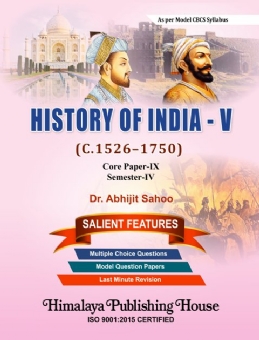The book on “HISTORY OF INDIA – V (c. 1526-1750)” is not a research work. It is a textbook that has been written for the History Honors Students (2019-20) of the CBCS courses designed as a common syllabus for all Universities of Odisha. For the convenience of the students, different terminologies are clarified, summary recaps are given, points and sub-points are highlighted, model questions are given and LMR (Last Minutes Revision) is also supplied.
In the first unit of the book, a vivid depiction has been made on India on the eve of the advent of the Mughals, Military technology – Firearms, Sher Shah: Administrative and Revenue reforms. In the following units, discussions were also made on the consolidation of Mughal rule in India; incorporation of Rajputs and other indigenous groups in Mughal Nobility; Jahangir, Shah Jahan and Aurangzeb; evolution of administrative institutions: Zabti, Mansab, Jagir, Madad-i-Maash; emergence of the Marathas; Shivaji and expansion under the Peshwas. Focus has also been given on the Society and Economy during the Mughal period, i.e., land rights and revenue system: Zamindars and peasants, trade routes and patterns of internal commerce; overseas trade; and growth of urban centers, craft and technology. The subsequent chapter deals with topics like religious tolerance and Sulh-i-Kul, Sufi mystical and intellectual interventions, Mughal Art and Architecture, and Mughal and Rajput paintings: themes and perspectives.
Chapterisation of this book is student-friendly and as per the new common syllabus. The language of the content is very simple and lucid as a common student can easily grasp and appear for the examination. In preparing this book, I have taken the help of classical as well as contemporary books on the topics. I have also gone through different websites dealing with the subjects. All the units of this book have been presented in a systematic and comprehensive manner. I hope that this book will surely fulfill the requirement of both students and teachers.
Contents –
UNIT-I: ESTABLISHMENT OF MUGHAL RULE
1. India on the Eve of Advent of the Mughals
2. Military Technology – Firm Arms
3. Sher Shah: Administrative and Revenue Reforms
UNIT-II: CONSOLIDATION OF MUGHAL RULE
4. Incorporation of Rajputs and Other Indigenous Groups in Mughal Mobility
5. Jahangir, Shah Jahan and Aurangzeb (1569-1707 A.D.)
6. Evolution of Administrative Institutions: Zabti, Mansab, Jagir, Madad-I-Maash
7. Emergence of the Marathas; Shivaji; Expansion under the Peshwas
UNIT-III: SOCIETY AND ECONOMY
8. Land Rights and Revenue System: Zamindars and Peasants
9. Trade Routes and Patterns of Internal Commerce; Overseas Trade
10. Urban Centers, Craft and Technology
UNIT-IV: CULTURAL IDEAS
11. Religious Tolerance and Sulh-I-Kul
12. Sufi Mystical and Intellectual Interventions
13. Mughal Art and Architecture
14. Mughal and Rajput Paintings: Themes and Perspectives
Multiple Choice Questions of all Units
Core Paper – IX (Model Questions)
Last Minute Revision
Chronological Table
Books for References






